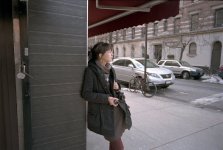Redseele
Established
Hi all,
I just got back a roll of Fuji Pro 400H which I overexposed by two stops (shot it as if it were 100 ISO). I scanned them in my new Proscan 7200 but all pictures came out with a brownish and muted colors. Is that normal for overexposing this film? The day was bright and I shot it with a Voigtlander 25mm f4 Color Skopar, so it should be very contrasty, so I was very surprised at the results. IN the past black and white negatives are always flat when first scanned, but I'm not very experienced with color negatives, therein my doubts.
As I said, this is the first time I've shot 400H overexposed like this, so I was wondering if anyone thinks I may have done something wrong. For my scanning method I used Colorperfect with the guide provided here:
http://www.l-camera-forum.com/leica...r-negative-scanning-vuescan-colorperfect.html

scan0019 by Mahler_seele, on Flickr
Any help or comments would be appreciated 🙂
I just got back a roll of Fuji Pro 400H which I overexposed by two stops (shot it as if it were 100 ISO). I scanned them in my new Proscan 7200 but all pictures came out with a brownish and muted colors. Is that normal for overexposing this film? The day was bright and I shot it with a Voigtlander 25mm f4 Color Skopar, so it should be very contrasty, so I was very surprised at the results. IN the past black and white negatives are always flat when first scanned, but I'm not very experienced with color negatives, therein my doubts.
As I said, this is the first time I've shot 400H overexposed like this, so I was wondering if anyone thinks I may have done something wrong. For my scanning method I used Colorperfect with the guide provided here:
http://www.l-camera-forum.com/leica...r-negative-scanning-vuescan-colorperfect.html

scan0019 by Mahler_seele, on Flickr
Any help or comments would be appreciated 🙂








